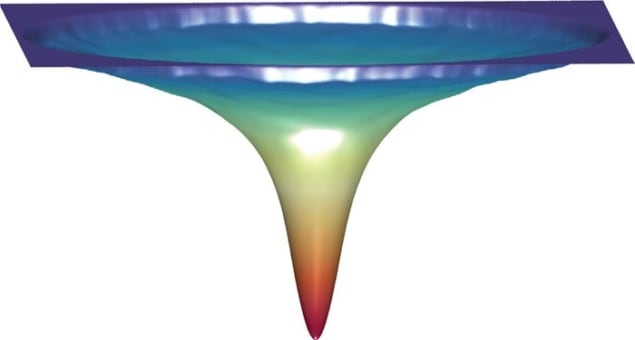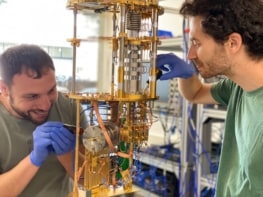
Computer simulations by researchers in the US and China could lead to solar cells that work efficiently across a broad range of the solar spectrum. Dubbed a “solar energy funnel”, the new concept offers a way of using strain to modify the band gap of a semiconductor so that it responds to light within a range of different wavelengths. However, the funnels have yet to be made and tested in the lab – some researchers suggest using them in practical devices could prove problematic.
The basic operating principle of a solar cell is that an electron in the valence band of a semiconductor material absorbs a photon and jumps across an energy “band gap” into the conduction band. The result is an electron and a positively charged hole, which do not move separately through the semiconductor but instead form a bound state called an exciton. To extract electrical energy, the electron is collected at one electrode and the hole at another.
Light from the Sun comes in a range of wavelengths and therefore an ideal solar cell should be very efficient at converting this broad spectrum into electricity. Unfortunately, semiconductors with a fixed band gap are not very good at doing this. In particular, longer-wavelength photons do not have enough energy to make an electron to jump the band gap and will not be converted into electrical energy. Photons with energies greater than the band gap will be converted, but regardless of their energy they will only create just one electron–hole pair. Any excess energy will be dissipated in the semiconductor as heat.
Tweaking the band gap
One way of getting around this problem is to create a cascaded solar cell comprising several layers of semiconductor, each with a different band gap. However, these are complex and expensive to produce. Now Ju Li and colleagues at the Massachusetts Institute of Technology, Peking University and Xi’an Jiaotong University say they have come up with a way of tweaking the band gap within a single layer of atoms. The technique is based on elastic strain engineering, a method that has been used by the electronics industry to boost the performance of silicon transistors.
While silicon crystals are not strong enough to sustain the elastic strain necessary for making better solar cells, some other semiconductors are. Molybdenum disulphide, for example, has a layered crystal structure – with individual layers being extremely strong. The material has a relatively large band gap of 1.9 eV at zero strain so most solar energy would pass through without being absorbed. However, when strain is added, the band gap shrinks continuously to 1.1 eV – which is identical to that of silicon.
The team made its calculations using computer models of the mechanical and electronic properties of single layers of molybdenum disulphide. Calculations were made on layers that are periodically indented with the tip of an atomic force microscope and then clamped at the edges to ensure that the tiny indentations stayed put. The calculations suggest that the band gap would vary periodically as a function of position on the structure. Furthermore, the simulations indicate that the wavy band gap would allow the sheet to absorb photons with a variety of different energies and “funnel” the resulting excitons towards the centre where the band gap was smallest. The team believes that this directional drift provides a means for photons with energies between 1.1–2 eV to be harvested efficiently by collecting excitons at multiple points in the funnel.
Driving excitons
Li explains that this gradient in the band gap would allow the excitons to be driven towards the electrodes electromagnetically. This would allow them to be collected more quickly than in a traditional solar cell design, where excitons diffuse towards the electrodes. This could make the solar cell more efficient, explains Li: “You want to absorb different parts of the spectrum and then collect the excitons before they recombine or lose their energy to phonons”. “And having this funnel and this exciton drift instead of a random exciton walk will assist in this exciton collection process,” he adds.
Di Xiao of Carnegie Mellon University in Pittsburgh is very impressed by the team’s prediction of continuous band-gap modification using elastic strain. However, he suggests that the group will encounter a practical difficulty in applying its research to real solar cells, which tend to be much thicker than a single layer in order to maximize light absorption: “In a traditional silicon solar cell…the light has to travel a very long way within that silicon, so it has a much larger chance to be absorbed. But in a monolayer, once it is passed through the material it is gone.”
Another researcher, an expert in solar-cell design who asked not to be named, was more sceptical, doubting that the concept would be of practical use in solar cells because of the difficulty of stopping light with an atomic monolayer. He was also doubtful that it would be feasible to harvest any extra energy by using the solar-funnel method.
The research is published in Nature Photonics.



